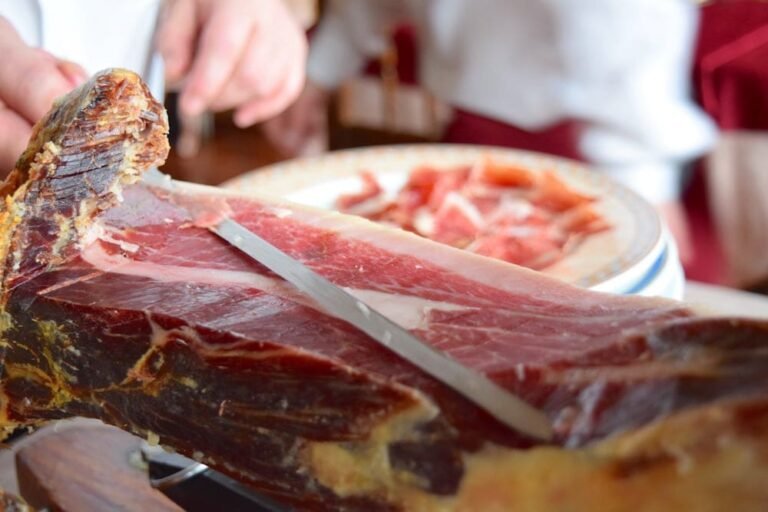
[ad_1]
If you had to pick just one food to eat for the rest of your life, what would it be? I know what I’d go for: Spanish ham.
In Spain, there’s nothing quite as important as ham. It’s bigger than religion, bigger than football, and goes beyond just a regular obsession. This isn’t just food, it’s life. Don’t believe me? Just ask a local!
All you need to do is mention jamón ibérico to a Spaniard and you’ll see their eyes glaze over and their mouth start to water.
But what’s the big deal?
Locals might lose their minds for this stuff, but why? And what do you need to know before you get to Spain and start ordering your own ham at a bar? How do you know which type of ham to buy?
If you go to a restaurant in Spain, you’ll see up to three or four kinds of Spanish ham on the menu, with prices ranging from five euros a kilo to over 100 euros a kilo! So what’s the difference, and are the pricier varieties actually worth it?
Below I’ll answer all these questions and more! Let’s dive into the delicious world of Spanish ham with this guide to all things jamón serrano and jamón ibérico.
The Best Ham in the World
There are few foods that are more Spanish than ham. Alongside gazpacho and paella, it might just be the country’s most iconic food.
Spanish ham (jamón) is the one food that all Spaniards, by virtue of just being Spanish, have to like. Whenever I’ve heard a foreigner say they don’t like jamón, the response of every single Spaniard has been, “well then you haven’t tried the good stuff!”
Because for Spaniards, there’s no way that anyone couldn’t like ham!
The “good stuff” is jamón ibérico de bellota, a melt-in-your-mouth, otherworldly ham experience. This is one of the world’s most sought-after foods, and holds records for its headache-inducing prices.
These Spanish beauties are the world’s most expensive legs of ham, sometimes going for $4,500 each. Jamón ibérico even holds the world record for the most expensive commercially available leg of ham, sold for more than $13,000.
But before you reach this ridiculously delicious (and very expensive) level of Spanish ham, there is a plethora of styles, breeds, cures, and colors to choose from. Let’s break them down.
What Is Spanish Jamón?
Spanish ham is the best thing that can happen to the back leg of a pig. Rather than cooking the ham, you make jamón by dry-curing the leg. After slaughter, the legs are trimmed and cleaned, and then stacked in a barrel full of salt. They’re left for roughly two weeks to drain as much moisture as possible!
After that, the salt is wiped off and the legs are left to hang and cure. The meat is carved off of the bone and often served alongside other cured meats, sausages, and cheeses as an appetizer.
The Spanish tradition of ham-making dates back more than 2,000 years to when the Roman Empire controlled most of the country. Even to the exotic palates of the Romans, Spanish ham was a delicacy. Pliny the Elder even praised jamón for its complexity, arguing that “the flesh of these hogs has nearly fifty flavors!”
But for hundreds of years, cured ham legs were a specialty reserved only for royalty and the clergy. It wasn’t until the 13th century that ham made its way to the everyman’s table. Today, the average Spaniard eats more than 7 pounds of cured ham per year!
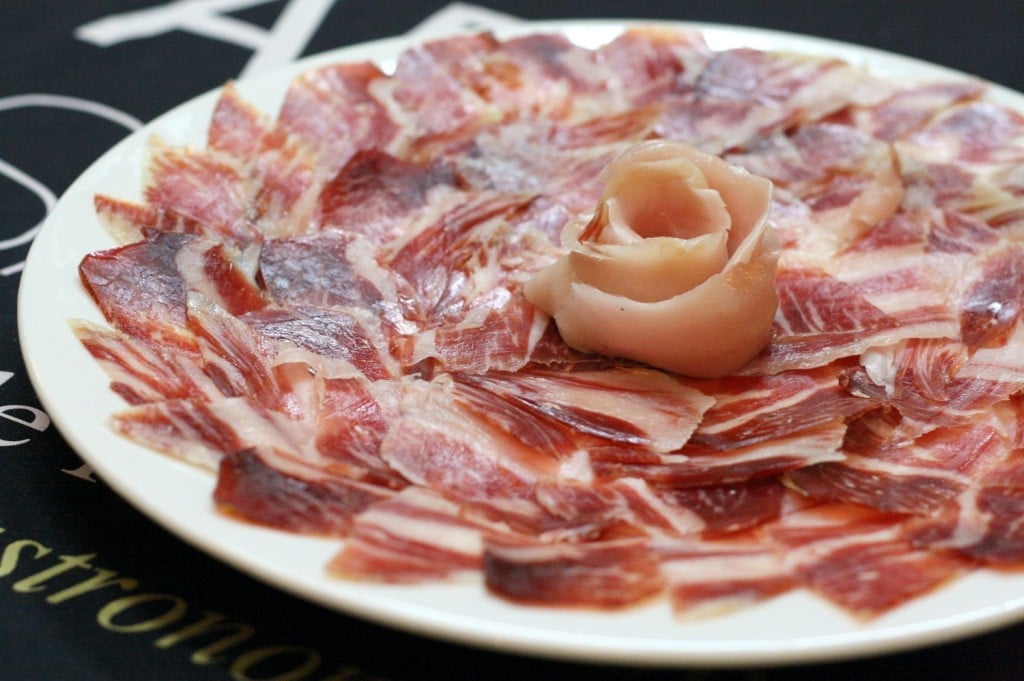
But under that broad umbrella of jamón there is massive variation in price and quality, and a difference in the type of pig it comes from, too!
In fact, the most important variable is the breed of the pig. Because when it comes to Spanish ham, not all pigs are born equal.
Serrano Ham
Jamón serrano is the name of the most common type of Spanish ham. In fact, it makes up 93% of all ham production in Spain!
You’ll see it in supermarkets and on bar menus, and can eat it as a snack or on a sandwich. It’s simple and tasty, but it’s the least special kind of ham. If this is the only ham you eat while you’re in Spain, you’ve done yourself a disservice!
But while it may be considered the lower-level, everyday Spanish ham, its quality (and price) can still vary quite a bit.
So just what is jamón serrano, and how is it different from Iberian ham?
White Pigs (Cerdos Blancos)
Serrano ham comes from pigs with the slightly misleading name of “white pigs.”
If you picture a pig, you’re probably imagining a cerdo blanco. These pink animals are a common sight throughout the world, and the breed is usually Landrace, Large White, Duroc, or Pietrain. They were purpose-bred for industry, suited for mass production of pork.
You might be thinking, if the pig’s pink, why is it a “white pig”? Aside from being much paler than their Iberian cousins, the proof is in the hoof. These pigs have white or light brown hooves. Look for it the next time you’re in a Spanish bar! (The hoof is always kept on the leg at the bar! It’s the quickest way to tell the quality of the ham, so make sure to seek it out).
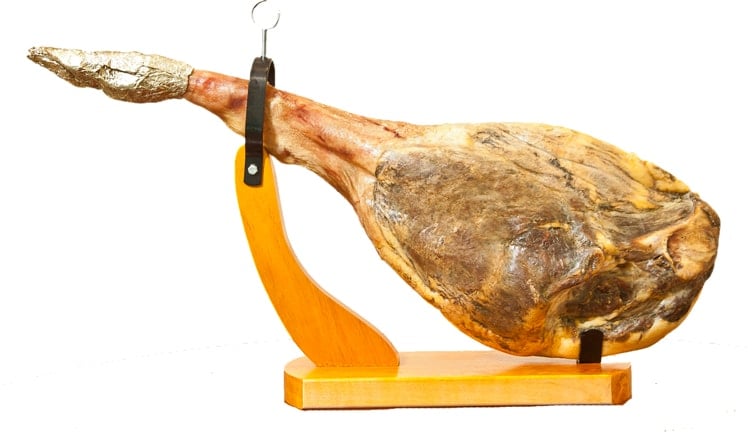
White pigs are almost always farmed intensively in enclosed pig houses and fed a grain-based pig feed. They normally live for no more than eight months, at which point they weigh around 90–100 kilograms. At its most commercial, the leg is cured for the bare minimum amount of time, and is ready for sale no more than 12 months later.
Due to these pigs’ breed, living conditions, and diet, the fat is not integrated into the meat. You’ll see that serrano ham has broad strips of pink meat alongside strips of pure white fat, with no marbling. The fat content of the pig is around 25%.
Types of Serrano Ham
While this more industrial ham is consequently not that special, you can still find different levels of quality.
Since 1990, the Consorcio Serrano (the official serrano ham regulators) have helped enforce the standards of serrano ham. Today, you can find hams both with and without their official production guarantee. While producers don’t have to be approved by the consortium, there are some key differences that you should be aware of.
Jamón Consorcio-Serrano (guaranteed by the regulatory consortium):
- Farms must be inspected and audited for quality.
- Pigs must be sourced from Spain, and farms must be based in Spain.
- There must be a 12-month minimum curing time.
Jamón Serrano (not guaranteed by the consortium):
- Farms are not necessarily inspected.
- Pigs may be sourced from anywhere in the world, but farms must be based in the EU.
- There must be a 7-month minimum curing time.
And even within these two classifications, there are three more sub-types of serrano ham. Just as important as the Consorcio, these labels are based on how long the ham has been cured. Bear in mind that the pig will still only have lived for eight months in an industrial setting, and been fed a grain- and cereal-based diet.
- De Bodega – cured between 1 and 12 months
- Reserva – cured between 12 and 15 months
- Gran Reserva – cured for longer than 15 months
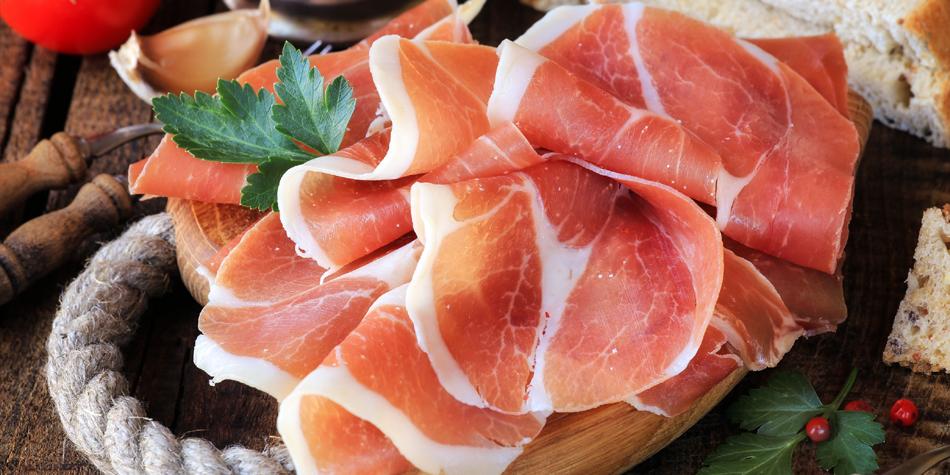
Iberian Ham
This is where the magic happens.
Although it only accounts for 7% of production, Iberian ham is the best kind of Spanish ham. It’s the stuff that makes Spaniards weak at the knees, and makes grown men weep with joy! While there are some reasonably priced hams for around 100 euros, you’ll also see legs sold for over 1,000 euros at any good deli in the country.
So what makes this Spanish ham so special? It’s all about the pig.
Iberian Pigs (Cerdos Ibéricos)
If these meter-long, fat-covered pig legs look positively medieval, it’s because they are.
The best Spanish hams come from Iberian pigs, a dark-haired, black-footed ancient breed that’s known for delectable marbled meat. You can identify Iberian hams at a market or restaurant by the color of the hoof, which is black. In fact, this hoof is so important that most locals just call Iberian ham “pata negra“—black-foot ham!
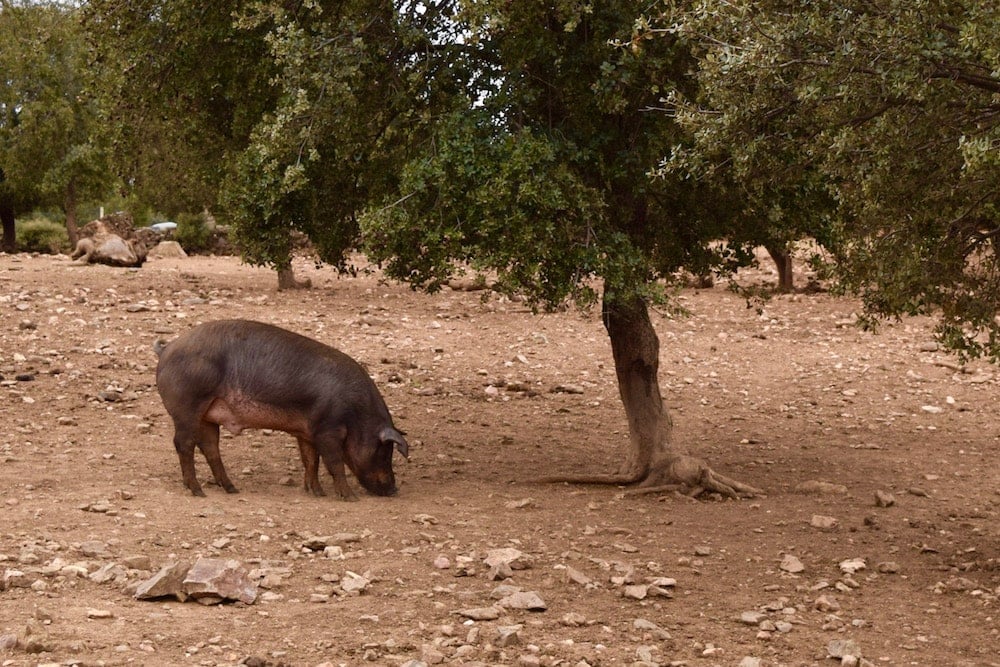
These pigs are native to the south of Spain and Portugal, where they’ve roamed for thousands of years. Phoenician traders brought the first pigs to the Iberian Peninsula, where they mated with local wild boars to produce the iconic Iberian pig.
You can tell these pigs apart from cerdos blancos by their jet-black skin and fur, their long ears and snouts, and their iconic hooves. These pigs are also unique in terms of their lifestyle; Iberian pigs play a crucial role in their local ecosystem.
Acorn-Fed Pigs
To make the top-quality ham, some pigs get treated like royalty. Once they’ve reached 100 kilos in weight, the piggies freely roam the forest-filled pastures of the farm (called a dehesa), full of olive groves, acorn trees, chestnut trees, and wild herbs. The pigs help to fertilize the area, and the trees in turn provide their food.
Aside from the wild herbs and grass of these pastures, the main food available to the pigs are acorns (bellotas). During fall and winter, the pigs are let out to roam freely and gorge on acorns, eating up to 20 pounds of them each, per day! As a result, every pig gains about two pounds of weight for every day of this process.
The sweet, nutty flavor of the acorns permeates deep into the meat, giving it a subtle and unique taste. The pigs also absorb oleic fatty acid from the nuts, changing the biology of their body fat. Because of the health benefits associated with plant-based fats, this ham has even been proven to lower your body’s cholesterol!
But unfortunately, not all Iberian ham is produced like this. So how can you tell the acorn-fed ham from the rest?
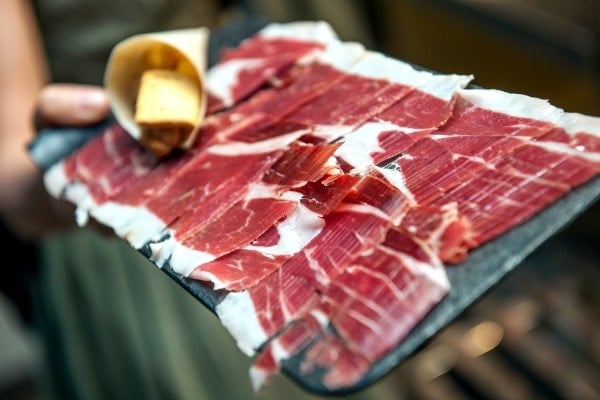
Types of Iberian Ham
Luckily, the Spanish government strictly controls the quality of Iberian ham.
Jamón ibérico is broken into different quality categories based on the pigs’ diet, and the percentage of Iberian genes present in each pig. You’ll see this marked on the leg by a colored label just above the hoof! They come in four colors: black, red, green, and white (in descending order of quality).
Jamón Ibérico de Bellota
- This is the best ham in Spain.
- These pigs forage for acorns in open fields each winter and fall.
- Look for a black tag, which signifies the ham came from a full-bred Iberian pig. Only about 5% of Spanish ham bears a black tag.
- A red tag means that that the pig has roamed free in acorn orchards, but is not 100% genetically Iberian. It must be at least 50% Iberian pig, with the rest a cross with a Duroc pig. These legs must be cured for at least three years and up to five years.
Jamón Ibérico de Cebo de Campo
- These are what you might call “free-range” pigs, and are at least 50% Iberian. They forage for their food in open fields, eating wild plants and some acorns. But they don’t get enough acorns to make up a full diet, so the farmer supplements them with a cereal-based feed.
- These hams are marked with a green tag, and must be cured for at least three years.
Jamón Ibérico de Cebo
- These pigs are raised on grain and cereals (cebo), and eat little to no acorns. Think of these as your conventionally farmed pigs, which are at least 50% Iberian.
- This category accounts for about two-thirds of all Iberian ham production and is cured for at least two years. You’ll see it marked with a white tag.
Where Does Iberian Ham Come From?
While you can make serrano ham anywhere in Spain, the requirements for jamón ibérico are much more strict!
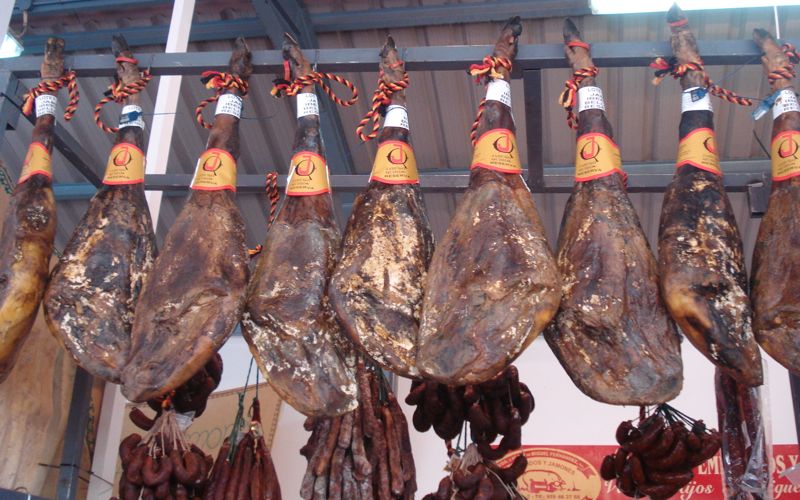
Just like Spanish wine and olive oil, Iberian ham is protected by the EU’s regime of Protected Designations of Origin. These appellations define where and how you can make the traditional foods of a country, to protect heritage and standardize quality.
Given that the specific characteristics of the land and dehesa are so important to the production of Iberian ham, the EU recognizes four distinct appellations for acorn-fed jamón ibérico. They are:
- D.O.P. Jabugo: In Andalusia, near Seville and Huelva.
- D.O.P. Extremadura: Western Spain, around Badajoz and Cáceres.
- D.O.P. Los Pedroches: Also in Andalusia, near Córdoba.
- D.O.P. Guijuelo: This appellation includes almost two-thirds of all jamón ibérico de bellota. It’s also the largest, covering ground in Extremadura, Castilla y Leon, Castilla La Mancha, and parts of Andalusia.
How to Eat Spanish Ham
It would practically be blasphemy to suggest that great Spanish ham should be eaten any other way than thinly sliced (always by an expert, always by hand) and on its own.
Carving ham is considered a serious skill in Spain, and maestros spend years training and practicing. There’s even an annual festival of ham near Seville, including a national ham-slicing competition!
Jamón ibérico is usually served solo. Don’t try and eat it on a sandwich or with cheese, as locals say you should only pair it with more ham! It’s a common appetizer, and often the first course at banquets and weddings.
Serrano ham, on the other hand, is different. Given that this ham isn’t quite as delicious as the Iberian stuff, you’ll see it on sandwiches throughout the country. It’s also a popular ingredient in many Spanish recipes.
In terms of Spanish wine pairings, jamón ibérico de bellota needs nothing more than an accompanying glass of red wine, or a dry and nutty sherry!
What to Eat With Spanish Ham – Recipes
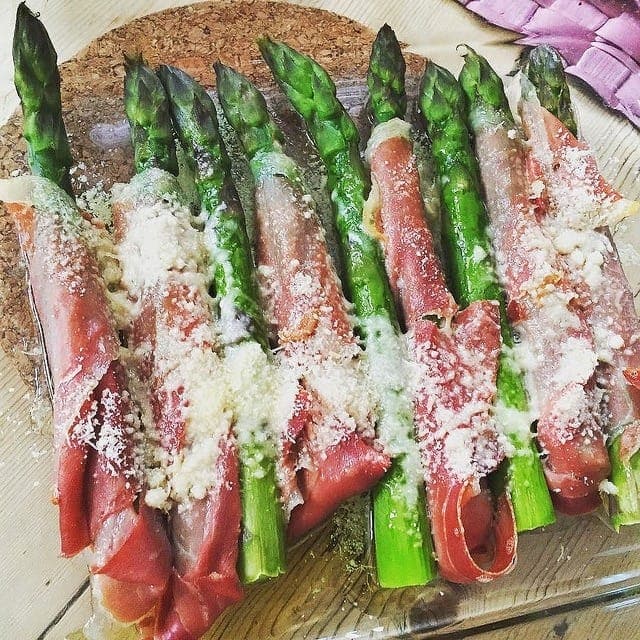
Note: If you’re planning on bringing Spanish ham back home with you after your trip, keep in mind that some countries—such as the US—won’t allow it. Save yourself the trouble at customs and purchase your jamón online instead. Retailers like La Tienda offer excellent-quality Spanish ham and ship throughout the US.
Spanish Ham FAQs
The Spanish word for cured ham is jamón. In Spain, you’ll see either jamón serrano or jamón ibérico. Both are cured Spanish ham, but they have different standards in terms of quality and production.
Spanish ham is recognized as one of the world’s best cured meats for good reason! The rigorous production standards and unique methods of raising the pigs ensure that the ham is incredibly flavorful, with a melt-in-your-mouth texture that’s nearly impossible to replicate.
Iberian ham has higher quality standards than serrano ham, and comes from a different type of pig. Because of this, it’s more expensive—and more delicious! You can distinguish legs of jamón ibérico and jamón serrano by the color of the hoof (black and white, respectively).
Prosciutto is similar to Spanish serrano ham in that it comes from a similar type of white pig (cerdo blanco). However, these two types of cured ham have very different flavors and textures! And of course, prosciutto is Italian, while serrano ham is Spanish.
Hungry for more? Sign up for my free weekly newsletter and receive a new Spanish recipe once a week! Join today and get my FREE Spanish ingredient essentials guide!
[ad_2]
Source link